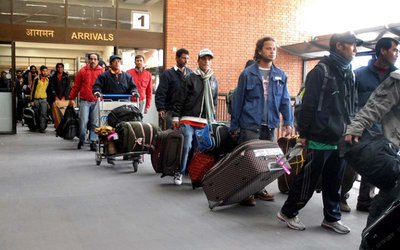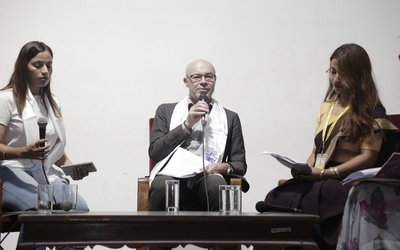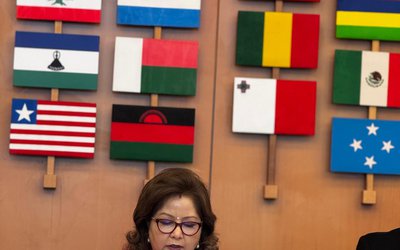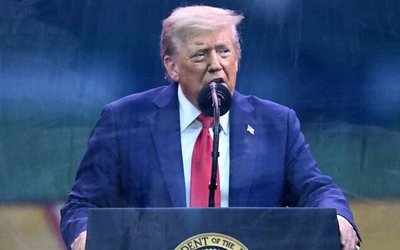Surprising the entire nation, Prime Minister Oli on December 20 dissolved the House of Representatives (HOR), and called mid-term polls to be held in two phases, pushing the country into a state of serious chaos and instability. Oli had no problem at all in securing President Bhandari’s endorsement who wasted no time in formalizing Oli’s proposal related to the untimely demise of the House and holding of elections in two phases on April 30 and May 10. Understandably, this move of Oli came in the backdrop of the accentuated feud within the Nepal Communist Party (NCP) and the rival faction led by Prachanda\Nepal pressuring him to step down either as head of the government or party co-chair. Seemingly, he also ran the high risk of losing both jobs because he had fallen into minority in all the important bodies of the party and HOR where, it appeared, a no-confidence motion against him could be passed without much difficulty. A smart Oli, however,preemptied all these likely moves by the rival faction with the sincere cooperation of the President whose good office even refused to register a petition signed by 83 CPN lawmakers requesting her to summon a special session of the Parliament.
Legal experts are more or less unified in observing that Oli’s move was unconstitutional and President Bhandari should not have put her seal of approval on it in haste and without any consultation whatsoever. It is said that the present constitution, unlike the 1990 constitution, does not have a provision that allows a majority government to dissolve the House. The faction led by Prachanda|Nepal, which claims to have about two-thirds central committee members, has appointed Nepal as co-chair in place of Oli and Dahal has also been unanimously chosen as the parliamentary party leader, removing Oli from the post and ultimately expelling him from the general membership of the party as well. Similar punitive actions such as stripping Dahal of his executive powers have been taken against him by the faction led by Oli. In addition, the two rival factions of CPN are seen engaged in battles on several fronts and the rivals are busy trading accusations, most often making derogatory observations, and cracking jokes to the delight of listeners\viewers. Since the media coverage nowadays of their activities is so wide and effective that not only those who attend their programmes in person have the benefit of entertaining themselves but the viewers\listeners miles away from the point of jocular activities have also been lucky enough to have access to this recent source of cost-free entertainment. Although a very good orator himself, Prachanda appears no match for Oli as far as the question of making people laugh or entertaining them is concerned. In addition to the entertainment aspect, some of their revelations have given people information, some very serious, about their leaders and the party, which many people would not have known had it not been for this serious intra-party feud. Oli seems to be having a tough time sending back befitting replies to numerous attacks on him by the three heavyweights (Prachanda, Nepal and Khanal) of the rival faction who are also well known for their oratory power.
The battle between the two feuding factions is being fought on multiple fronts- Supreme Court, Election Commission and streets of Nepal, mainly Kathmandu, that receive almost every day protesters opposing the move and occasionally some appear even to defend Oli’s action as well. The apex court has already begun hearing on petitions challenging Oli’s move to dissolve the HOR, which many experts term as unconstitutional and some even finding it tantamount to a constitutional coup. While the petitioners and other experts have made it amply clear that the present constitution does not have a provision, unlike 1990 one, that allows a majority government to dissolve the House, some opine that the constitution does not prevent a prime minister from going to the people at a time when he feels seriously constrained to operate due to problems created by his own party colleagues. We have no choice but to wait for the verdict.
The Election Commission (EC) was also approached by the feuding factions doing everything possible such as Oli expanding the Central Committee basically to outnumber the signatures of majority members (290) submitted to EC by the rival faction. Despite these efforts of the two factions staking claim to the party flag and election symbol, EC very smartly decided not to take sides with any of the two feuding groups, concluding that NCP was still one party as it had not received any request from any quarter to split the party. Hope this decision, not very much liked by the anti-Oli faction, does not contribute towards further shaking the nation.
In addition to the two rival factions of NCP, several other political parties and non-political organizations have taken to the streets, strongly protesting this move as unconstitutional. Although refusing to launch joint agitation programmes with the NCP faction led by Prachanda\Nepal, NC has been regularly organizing activities against this move. Looking at the site\area selected for the phased agitation and balanced statements of Deuba, it is almost clear that there is a tacit understanding within NC to criticize this unpopular decision of Oli and also ensure electoral gains, taking advantage of the divided NCP, should the apex court decide in favour of elections. Ostensibly, NC senior leader Poudyal and many others in the party have been aggressively condemning the move without seeming to be tempted by the electoral windfall likely to emanate from early polls. Anti Oli faction organized a huge protest gathering in Kathmandu on January 22 and preparations are being made for a befitting reply soon. On the whole, these activities, irrespective of organizers, have engulfed this Himalayan country where the new variant of Corona has been recently traced and Nepalis are getting increasingly frustrated because the economy has been hard hit by the pandemic, making it difficult for many to meet their basic requirements.
The World Bank (WB) has painted a very bleak picture of the economy, stating that our economy would grow by only 0.6 percent while overall South Asian growth would be 3.5 percent. Looks like the concerned authorities finally have no problem in agreeing with the WB’s revelation that last fiscal year our economy grew just by 0.2 percent and the nation will have to wait until 2022 to have 2.5 percent growth. International agencies expected the economy of Nepal to remain weaker in three fiscal years. Due to lack of employment opportunities, people have no income, which has adversely affected domestic demand for goods and services. The decline in import of petroleum products by 11 percent this year could have contributed a bit towards reducing our ballooning trade deficit but this is definitely not something to be happy about because reduced consumption of these products in most cases is a distinct pointer to reduced economic activities and declining growth. As stated by outside agencies, situation economically is not good, which can be corroborated by some other current facts about the economy.
Despite reported decline in imports and some improvement in exports, data made available for the last six months of this fiscal year show that Nepal imported goods and services worth Rs. 650 billion while our exports remained limited to Rs. 60 billion. The overall decline in imports, including a significant decline in imports of petroleum products, is attributed to the pandemic, which has inflicted serious injury on the economy. Government agencies report that petroleum import, despite the decline, was Rs. 20 billion more than Nepal’s total export during the last six months. It is said that about 57 percent of industries\businesses have now become fully operational and need support from the state to sustain their current level of operation. It may also be interesting to note that despite record production of paddy this year (increasing by 71 thousand metric tons to reach 5.6 million ton) due mainly to favourable weather conditions, rice import in the last five months amounted to Rs. 18 billion. Likewise,in keeping with the performance of this government in the last couple of years, progress on the capital expenditure front has continued to remain disappointing (14.4 percent of the allocated Rs. 352.91 billion) and so is the case with revenue collection, which remained at 41.73 percent of the targeted Rs. 1011 billion. Foreign direct investment has also registered a sharp decline. It is sad that, despite the nation already about a year into the pandemic, industrialists\businesses are still seen urging the government and the concerned agencies for tangible support and quicker delivery of whatever has been promised. Indeed, it is high time that we gave a serious look at the meaningful efforts made elsewhere, specifically in our neighbourhood.
The Indian economy has been hard hit by the pandemic, which is shown by the shrinkage it experienced in the last two quarters. A number of schemes are in place to help the ailing industries\businesses and there are strong suggestions coming from different quarters, including the ruling BJP, that efforts be made in the next budget to put more money in the pockets of middle- income families because this way government of India would be incentivizing consumption by them, which would help domestic industries and businesses. It is also very likely that the next budget would cut the cost of raw material for small and medium-sized businesses, which is likely to be effected through a substantial reduction in import duty. The government of India also looks determined to further increase investment on projects for roads, pipelines and ports to revive businesses and generate jobs to put the much-needed money in the pockets of people, focusing mainly on the middle-class(300 million of India’s total population of 1.35 billion),which is feeling a lot of pinches. India, fast emerging as a major economic power of global scale, looks engaged in a healthy competition on the economic front with the second-largest economy in the world and predictions are that it will be fast leapfrogging many other economies to be near China (likely to be the largest economy soon), which has become the first country to register positive economic growth of around 2 percent in 2020. Another mention-worthy fact about India is that it has launched the world’s largest vaccination drive to cover 300 million Indians and this is likely to be followed by another 270 million people. One of the world’s biggest drugmakers, India, has gifted millions of doses of Covid-19 vaccines to its South Asian neighbours, showing in very clear terms that it is with them in their struggle against the devastating pandemic. Hope the Nepal government does not take too much time to make good use of the one million doses of easy-to-store Oxford\AstraZeneca vaccine it has received. Indeed, we do not expect the Nepal government to perform miracles overnight or do something like US president Biden who has announced many measures, including the announcement of a 19 trillion dollar relief package days before his inauguration on January 20, but our authorities definitely have to learn to deliver on time, without attempting to veil the unstable situation and the problems arising there from.
Dr. Rawal is a former governor of Nepal Rastra Bank

Dr. Tilak Rawal
Dr. Rawal is former governor of NRB.
- Chaotic Nepal -II
- Jun 23, 2025
- Six Months Of Deuba And Oli
- Jan 25, 2025
- Prachanda Outsmarted
- Jul 19, 2024
- Prachanda Outsmarts Again
- Apr 14, 2024
- Prachanda Completes One Year
- Jan 26, 2024












